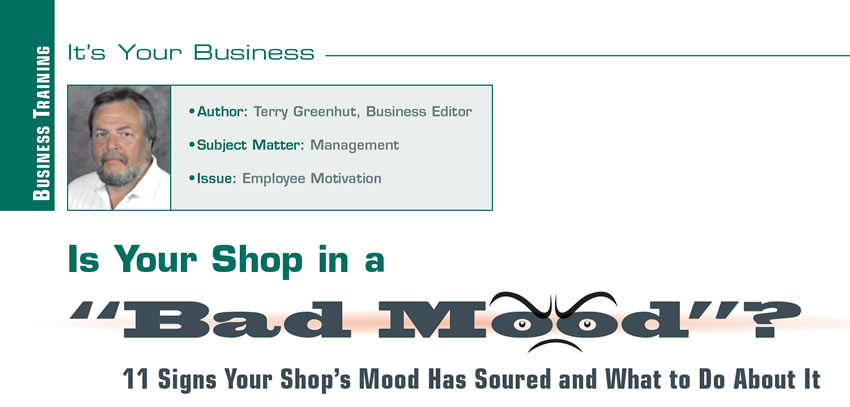
It’s Your Business
- Author: Terry Greenhut, Business Editor
- Subject Matter: Management
- Issue: Employee Motivation
11 Signs Your Shop’s Mood Has Soured and What To Do About It
When your whole shop has somehow worked itself into a bad mood it affects everyone. Customers, suppliers and employees are uncomfortable, and as a result, you lose productivity and sales. The spiral effect just continues downward until it reaches critical stage. Then, if something isn’t done to turn it around, all could be lost. So once the symptoms are recognized, changes need to be made quickly.
Is your company in a bad mood? The signs aren’t always obvious. People aren’t necessarily biting each other’s heads off or walking past each other without any form of acknowledgement. Instead, it feels like everyone is just trying to barely get through the day. They’re short with customers and other employees and it seems like they’re always just about an inch from snapping. Rather than digging for solutions, they make a cursory effort and then try to lay the problem off on someone else. They’re not being cage-rattlers or idea-sharers; they’re more like “yes men” and passive compliers. That’s how bad mood in workplace usually shows itself. Since your mood as a leader sets the tone for their mood, often the problem starts and needs to end with your leadership.
Sometimes a company’s mood sours over time, without you even realizing it’s happening. A stifling rule here, an ignored idea there, and before long you’ve zapped the entrepreneurial spirit that enabled your employees to create great things at your company in the first place. The only cure is to make your employees realize they really do have a stake in their future and the ability to make it a great one.
Of course, before you can shift a bad mood, you need to know you have one.

Here are 11 red flags to look for:

As soon as a ball is dropped, the finger-pointing and blame-dodging begins. “It was her responsibility, not mine!” “Don’t look at me – I wasn’t told about that policy change!” “He was supposed to email me the update, but I never received it!” You know how this goes, and odds are it isn’t happening because all of your employees are vengeful, spiteful jerks; it’s happening because employees are afraid of what the consequences will be for whoever is left holding the bag.
When a technical error is made, realize that making an example of the culprit isn’t necessarily the best way to go. Instead of blaming, aim your focus on figuring out what went wrong, and how you can prevent that error from occurring again.
My approach to mistakes was to say, “Congratulations! You found a new way to screw this up, and that’s a good thing. I didn’t think there were any more ways than the ones I did. So now that this has happened how can we keep it from happening again?” This attitude gave my employees the freedom to take risks, encouraged entrepreneurial thinking and led to an all-around better mood.

In organizations that are overshadowed by bad moods, most employees come to work each day and perform the tasks within their job description, but no more. If they don’t consider a problem to be “their responsibility,” they pass it on to the next guy or they take it to the boss expecting a solution.
At my shop we found that the key to turning worker bees into solutions-oriented entrepreneurs was simplifying our structure into just two divisions: Sales and Sales Support. This makes a lot of sense because every other activity in the shop is meant to support the sale that the service advisor is making. The reasoning behind this decision was simple: Everyone in your company gets paid from sales. Without sales, there simply is no money to pay salaries, bonuses, or benefits. When we began giving our Sales Support people bonuses based on quarterly sales amounts, we became more efficient, more responsive, and even closer-knit.

Some companies use information as a type of currency. The right juicy piece of info can buy you lunch, help get you a promotion, bring kudos your way, or be traded for other valuable information, and on the other hand, some information is downright suppressed because it may threaten someone in management’s concept of job security. Added up, that’s a recipe for disillusionment and mistrust amongst your workforce.
Instead of a need-to-know policy, I advocated a know-the-need approach. Your people are full of intelligence ideas, and passion; you just have to unlock those things! So do whatever you can to engage your entire team and keep the information free-flowing. Of course, you may be tempted to keep bad news and problems to yourself. Don’t. Be honest about the challenges your company is facing and ask the entire staff for solutions. You’ll probably get them!

Most companies have anything ranging from one person to a whole department dedicated to so-called “customer service”, but let’s be honest: For most of these departments, a more accurate name would be “complaint resolution department”. Employees take calls from unhappy customers and try to resolve the problem as quickly as possible, (usually based on some type of a script or predetermined protocol) then move on to the next. It’s a cold process that doesn’t leave the employee with a warm and fuzzy feeling of accomplishment. Over time this leads to a perpetual bad mood.
You can begin to turn this particular manifestation of a bad mood around by giving your employees more freedom when they endeavor to help customers. Instead of tying their hands with a script that’s unsatisfying and phony, show your people that you trust them to use their best thinking by giving them room to do what they think is necessary to satisfy the customer. This might involve getting rid of phone-call time limits or empowering them to offer free products and/or services to make up for inconvenience. Not only will your employees begin to really hone their entrepreneurial thinking skills, they’ll end each day with the satisfaction that comes from knowing that they transformed a disgruntled customer into a happy, loyal one.

If you notice that your employees prefer to handle complaints via email or text messaging – even when they don’t have to – it’s cause for concern. Very possibly, they feel that the solutions they are allowed to offer are inadequate, so they are embarrassed to offer them in a face-to-face meeting or even with a phone call.
First, you must make sure your employees have all the tools they need to feel comfortable with the solutions they are offering. Then you have to strongly encourage your people to meet with customers face-to-face whenever possible, while leading through your own example, of course. Over time, your employees will begin to develop strong, mutually fulfilling business relationships, and they’ll probably also see how much more effective communicating in real time can be. (No more misread emails or long waits for responses, and increased trust!) In most cases, job satisfaction will go up, and your people will start putting in face time voluntarily.

Think back on the recent interactions you’ve had with your employees. Chances are, they included phrases like, “I need you to do this,” “Please have that done by the end of the day,” and maybe even, “We need to talk about how you can improve.” But did any of those interactions include the words “thank you”? If not, you might be unwittingly contributing to your company’s bad mood.
Even if they’d never say so, workers want to know that they’re doing well in their boss’s eyes and that their efforts are valued. Don’t take it for granted when your employees put in extra hours, land a great sale or turn out an incredibly well-done job, for example. Make sure they know that you have noticed their efforts and that you’re grateful for their knowledge and help. In return you’ll gain their buy-in, loyalty and enthusiasm.

When your shop isn’t able to meet its goals, your first inclination might be to blame your employees for being unable to execute. And in turn, that blame probably will make an already bad mood even worse. So before doling out accusations, you should take a look in the mirror and make sure you aren’t using a leadership style that is keeping people from getting things done.
Do you find it difficult to delegate important projects? Do you insist on running every new project yourself? Are you a micromanager?
If you engage in any of these behaviors, it’s important to stop, step back, and show your people that you trust them to make important decisions and do important work. When you do, you’ll give your team the freedom they need to help move the company forward and you’ll free up a lot of time and energy for yourself as well.

If most of your employees’ ideas get stuck in limbo or are slapped down by you or others in authority, even the most innovative employees eventually will become discouraged or frustrated to the point of not speaking up with future ideas.
Of course, smart leaders should always look out for their company’s best interests, but are you being overly cautious? Are you afraid of the change the new idea could bring around? Not only should you give each idea employees bring to you fair consideration, it’s smart to proactively ask your people for their thoughts on how the company can grow and improve. At my shop some of our most valuable innovations came about because our people knew that their thoughts were valued and would be taken seriously.

People quit when they don’t like the environment in which they’re forced to work. There’s a myth that when company cultures are serious and businesslike, productivity improves. But the reality is, productivity improves when people enjoy being at work and enjoy the work they’re doing.
Don’t worry. I’m not saying that you have to put a basketball court and a bowling alley in your facility to make employees happy. I’m simply pointing out that when you strive to make it fulfilling and fun to work for you, you’ll create productive, loyal employees. Matching employees with positions that utilize their strengths and skills, and asking for their input regarding how they think they can be most valuable to the company goes a long way toward making them feel like integral members of the organization.
As for “fun,” we gave adequate time off, celebrated birthdays, let employees choose their own titles (puns were encouraged) and strove to make our shop an enjoyable place to work: light-hearted, cheerful and sometimes, a little silly.

Generally, all but the most frustrated, burned-out employees can manage to turn on the charm when they’re interacting with customers, so don’t assume that you’re worry-free because your team was chipper during a sales pitch. A much better way to gauge your company’s overall mood is to observe how employees interact with each other.
Employees who aren’t invested in your organization’s future usually won’t go out of their way to give pointers to the new hire. You want to create an atmosphere in which people are not afraid of being replaced. That way they’ll be willing to teach new employees to be as productive as possible. Match up rookie employees with more experienced mentors who can advise, teach, challenge and encourage them. They will appreciate the personalized guidance and be encouraged to form meaningful bonds with their colleagues right out of the gate. Plus, all but the most cynical veterans will soften when they see how fulfilling it can be to pass on their knowledge and expertise!

If vendors, suppliers, bankers and other third parties consistently fail to renew their contracts or maintain their relationships, your company’s mood may need a major adjustment. That’s because employees who aren’t invested in your company’s future are much more likely to treat these partners with a lack of respect, withhold information, tell white lies and be slow to respond.
Fortunately, it often takes only one leader (that’s you!) to break this pattern by setting a better example. Show your employees the difference it makes when you treat partners in a way that honors the relationship. For instance, treat salespeople with respect instead of dismissing them. Never have a ‘that’s just another salesperson’ attitude. Take their calls. Hear them out. When you treat third parties as valuable allies who can significantly influence your bottom line or help you survive; they often will. And that’s good for the morale of everyone involved.
Mood matters. Cultivating a good mood in your organization is the key to unleashing a strong entrepreneurial spirit in your people. If you’re not sure where to begin, go for the low-hanging fruit. Reread the list of bad mood indicators above, identify which one or two are the biggest inhibitors to progress in your shop and start there.














